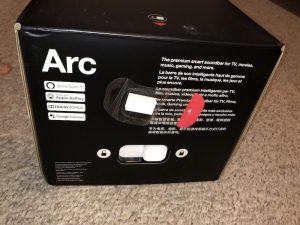Sonos debuted Arc – their long-anticipated Playbar replacement – in early June, boasting features like Dolby Atmos, sleek aesthetics and easy installation. Would this latest offering from Santa Barbara live up to all the recent hype? I was about to find out.
Unboxing Sonos Arc
Sonos has taken packaging to a whole new level. Arc arrives in a long rectangular box with sleek safety locks which open with a satisfying click on either end. Opening the box seems like the beginning of an exciting journey while also feeling like you’re supposed to preserve it for posterity because it’s so well designed.
Lifting the unlocked box cover reveals the Arc speaker encased in a cloth bag sealed with a Sonos sticker. That’s it. Nothing else to distract the eye. I love the simplicity!
Once the Arc speaker is out of the box, a separate accessory box is revealed underneath containing an HDMI cable, power cord, and optical audio adapter.
Sonos Arc Installation and Configuration

Like most Sonos products, Arc’s setup takes place inside the Sonos app. This was my first Sonos product that will only run on its new “S2” app, so I was curious to see how it would handle older S1 and newer S2 gear living side by side. In a perfect world, Arc seems best experienced in an all S2 environment. I’m still not sold on this bifurcation, but I get it. Time marches on and all legacy gear needs to sunset eventually.
I downloaded the S2 app, and it found the Arc speaker right away. Configuring the rest of the installation was a breeze, including the Trueplay calibration system which closely approximates saging a room with your smartphone to rid it of evil spirits.
The only installation snag I hit centered around control. I installed the Arc in a room with an existing Logitech Harmony remote and noticed that it wasn’t discovered right away by Logitech’s app. Since the TV I used didn’t have any spare HDMI ports, I decided to use the optical adapter. It became clear to me quickly that Arc should really be set up with an ARC (Audio Return Channel) capable setup if there’s a third-party remote in the mix. I finally figured out the Logitech Harmony integration, but it definitely took some time, and I realize my installation is probably an “edge case” for Sonos. If you have an ARC-capable TV, it’s a snap (you also get full Dolby Atmos sent through ARC versus none through optical).
Once I had everything set up and configured properly, I decided to watch some video content to see how Arc sounded. I connected a Fire TV directly to Arc and watched a few Dolby Atmos trailers. The immersive sound is the best I’ve heard from any speaker bar. I was skeptical of Arc’s ability to create full surround sound, but it does. It’s amazingly accurate with sound coming from above, behind, and all around as if there are speakers physically installed in those spots. The closest comparison I can make is what Bose did when it introduced Waveguide technology some years ago. It takes a lot to move my needle with new sound products, and Sonos Arc is a needle mover. Even without the Sonos Sub or any surround speakers, it puts out impressive low end and killer voice-channel reproduction.
Music sounds amazing on Sonos Arc, as well. I listened to a few TIDAL Master tracks, including “Round Here” by Counting Crows and “Sailing to Philadelphia” by Mark Knopfler. Both audio and video sounded great, cranked up, but also do well at low volume levels, which is key for any TV set up where families watch movies in the evenings and don’t want to be blown out of the water by whipsaw sound levels from commercials or jump scare scenes.
Final Thoughts on Sonos Arc
Sonos Arc is the new hands-down king of speaker bars. Its $799 retail price is really inexpensive given the build quality and sound performance. We’ve already sold a ton of them at my integration business, Livewire, and expect that pace to continue now that it’s clear that reality and hype evenly matched.










